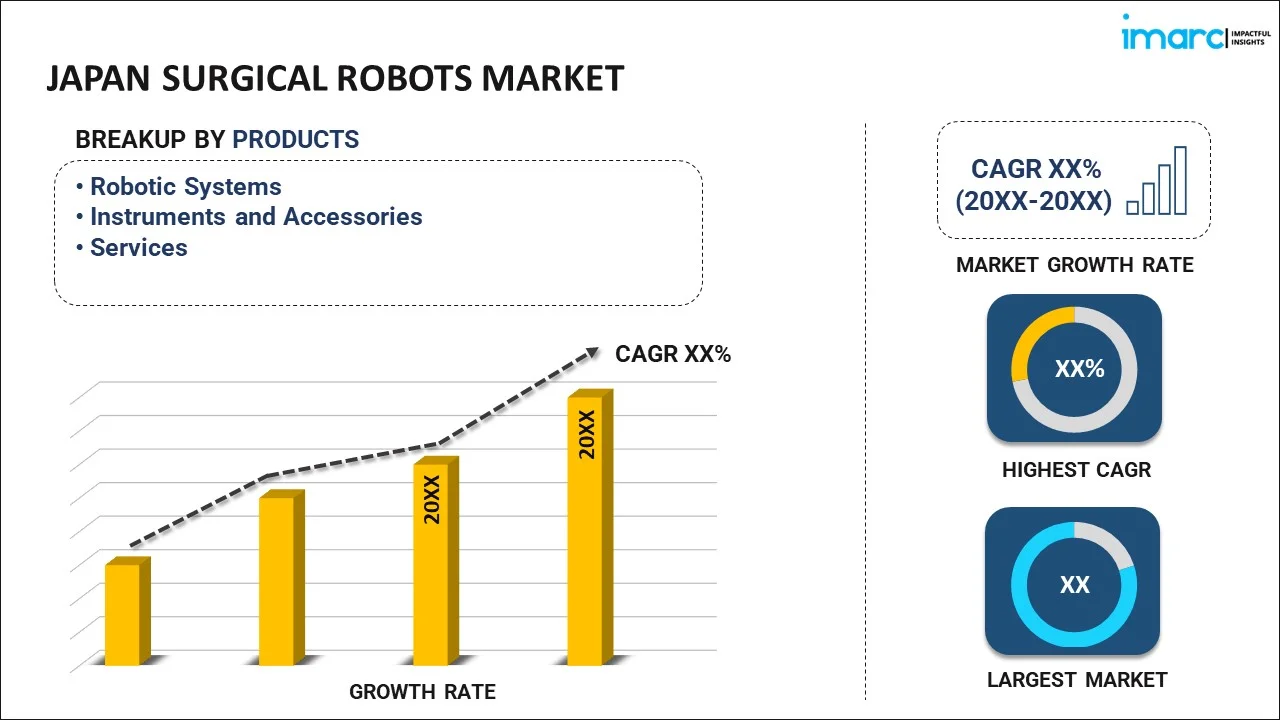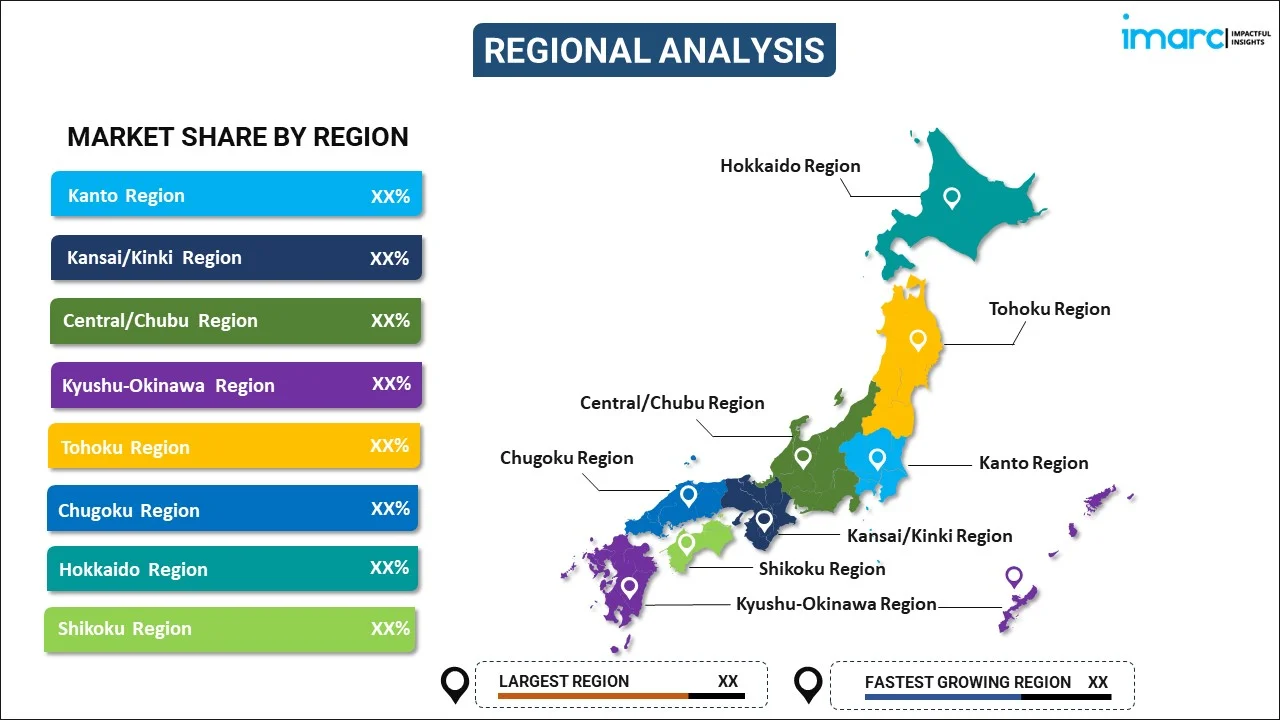
Japan Surgical Robots Market Report by Product (Robotic Systems, Instruments and Accessories, Services), Application (Gynecological Surgery, Urological Surgery, Neurosurgery, Orthopedic Surgery, and Others), End User (Hospitals, Ambulatory Surgical Centers, and Others), and Region 2025-2033
Market Overview:
Japan surgical robots market size reached USD 318 Million in 2024. Looking forward, IMARC Group expects the market to reach USD 876 Million by 2033, exhibiting a growth rate (CAGR) of 11.9% during 2025-2033. The growing demand for minimally invasive (MI) techniques by both patients and healthcare providers is primarily driving the market growth.
|
Report Attribute
|
Key Statistics
|
|---|---|
|
Base Year
|
2024
|
|
Forecast Years
|
2025-2033
|
|
Historical Years
|
2019-2024
|
|
Market Size in 2024
|
USD 318 Million |
|
Market Forecast in 2033
|
USD 876 Million |
| Market Growth Rate 2025-2033 | 11.9% |
Surgical robots are computer-controlled devices employed in minimally invasive (MI) and laparoscopic surgeries. These machines are equipped with a high-definition 3-D camera at the end of the robotic arm, delivering a precise visualization of body parts. They mimic the hand movements of surgeons and execute intricate procedures with miniaturized surgical instruments that can navigate through small incisions. In contrast to conventional surgeries, these robots present advantages such as swifter recovery periods, diminished post-operative discomfort, and lower risks of infection and scarring. Surgical robots are equipped with advanced features like 3D imaging systems, high-definition microscopic cameras, data recorders, motion sensors, and robot-controlled catheters, enhancing surgical precision and outcomes.
Japan Surgical Robots Market Trends:
The Japan surgical robots market is witnessing substantial growth, primarily fueled by the escalating prevalence of neurological disorders on a wide scale. Additionally, the increasing geriatric population, more prone to medical conditions, is another significant contributor to the market's expansion. Besides this, the widespread adoption of surgical robots for various procedures, coupled with the growing preference for minimally invasive (MI) techniques by both patients and healthcare providers, is a major catalyst for the market growth. Notably, neurosurgical robots are enhancing precision in procedures such as needle positioning in deep intracranial lesions and delicate neural structure retraction. Furthermore, technological advancements, particularly the integration of Artificial Intelligence (AI), Internet of Things (IoT), and virtual and augmented reality (VR/AR) in the healthcare sector, are additional drivers of market growth. As such, surgical robots are now equipped with 3D imaging systems, high-definition microscopic cameras, data recorders, motion sensors, and robot-controlled catheters, aiding surgeons in accurately performing complex procedures, which is acting as another significant growth-inducing factor. Apart from this, increased funding and investments in research and development (R&D) in robotics and medical sciences, alongside improving healthcare infrastructures, are projected to further propel the market growth over the forecasted period.
Japan Surgical Robots Market Segmentation:
IMARC Group provides an analysis of the key trends in each segment of the market, along with forecasts at the country level for 2025-2033. Our report has categorized the market based on product, application, and end user.
Product Insights:

- Robotic Systems
- Instruments and Accessories
- Services
The report has provided a detailed breakup and analysis of the market based on the product. This includes robotic systems, instruments and accessories, and services.
Application Insights:
- Gynecological Surgery
- Urological Surgery
- Neurosurgery
- Orthopedic Surgery
- Others
A detailed breakup and analysis of the market based on the application have also been provided in the report. This includes gynecological surgery, urological surgery, neurosurgery, orthopedic surgery, and others.
End User Insights:
- Hospitals
- Ambulatory Surgical Centers
- Others
The report has provided a detailed breakup and analysis of the market based on the end user. This includes hospitals, ambulatory surgical centers, and others.
Regional Insights:

- Kanto Region
- Kansai/Kinki Region
- Central/ Chubu Region
- Kyushu-Okinawa Region
- Tohoku Region
- Chugoku Region
- Hokkaido Region
- Shikoku Region
The report has also provided a comprehensive analysis of all the major regional markets, which include Kanto Region, Kansai/Kinki Region, Central/ Chubu Region, Kyushu-Okinawa Region, Tohoku Region, Chugoku Region, Hokkaido Region, and Shikoku Region.
Competitive Landscape:
The market research report has also provided a comprehensive analysis of the competitive landscape. Competitive analysis such as market structure, key player positioning, top winning strategies, competitive dashboard, and company evaluation quadrant has been covered in the report. Also, detailed profiles of all major companies have been provided.
Japan Surgical Robots Market Report Coverage:
| Report Features | Details |
|---|---|
| Base Year of the Analysis | 2024 |
| Historical Period | 2019-2024 |
| Forecast Period | 2025-2033 |
| Units | Million USD |
| Scope of the Report | Exploration of Historical and Forecast Trends, Industry Catalysts and Challenges, Segment-Wise Historical and Predictive Market Assessment:
|
| Products Covered | Robotic Systems, Instruments and Accessories, Services |
| Applications Covered | Gynecological Surgery, Urological Surgery, Neurosurgery, Orthopedic Surgery, Others |
| End Users Covered | Hospitals, Ambulatory Surgical Centers, Others |
| Regions Covered | Kanto Region, Kansai/Kinki Region, Central/ Chubu Region, Kyushu-Okinawa Region, Tohoku Region, Chugoku Region, Hokkaido Region, Shikoku Region |
| Customization Scope | 10% Free Customization |
| Post-Sale Analyst Support | 10-12 Weeks |
| Delivery Format | PDF and Excel through Email (We can also provide the editable version of the report in PPT/Word format on special request) |
Key Questions Answered in This Report:
- How has the Japan surgical robots market performed so far and how will it perform in the coming years?
- What has been the impact of COVID-19 on the Japan surgical robots market?
- What is the breakup of the Japan surgical robots market on the basis of product?
- What is the breakup of the Japan surgical robots market on the basis of application?
- What is the breakup of the Japan surgical robots market on the basis of end user?
- What are the various stages in the value chain of the Japan surgical robots market?
- What are the key driving factors and challenges in the Japan surgical robots?
- What is the structure of the Japan surgical robots market and who are the key players?
- What is the degree of competition in the Japan surgical robots market?
Key Benefits for Stakeholders:
- IMARC’s industry report offers a comprehensive quantitative analysis of various market segments, historical and current market trends, market forecasts, and dynamics of the Japan surgical robots market from 2019-2033.
- The research report provides the latest information on the market drivers, challenges, and opportunities in the Japan surgical robots market.
- Porter's five forces analysis assist stakeholders in assessing the impact of new entrants, competitive rivalry, supplier power, buyer power, and the threat of substitution. It helps stakeholders to analyze the level of competition within the Japan surgical robots industry and its attractiveness.
- Competitive landscape allows stakeholders to understand their competitive environment and provides an insight into the current positions of key players in the market.
Need more help?
- Speak to our experienced analysts for insights on the current market scenarios.
- Include additional segments and countries to customize the report as per your requirement.
- Gain an unparalleled competitive advantage in your domain by understanding how to utilize the report and positively impacting your operations and revenue.
- For further assistance, please connect with our analysts.
 Inquire Before Buying
Inquire Before Buying
 Speak to an Analyst
Speak to an Analyst
 Request Brochure
Request Brochure
 Request Customization
Request Customization




.webp)




.webp)












